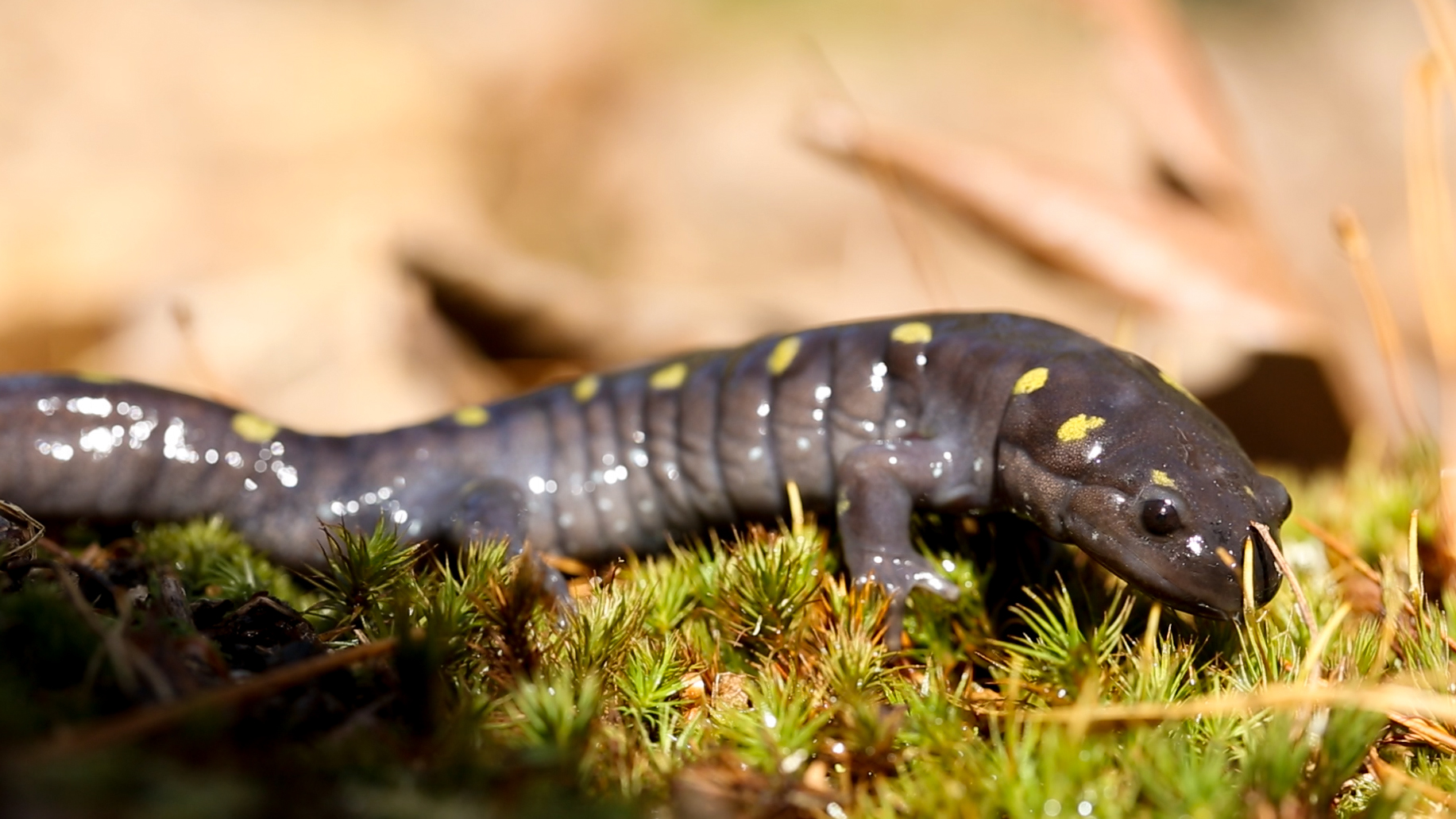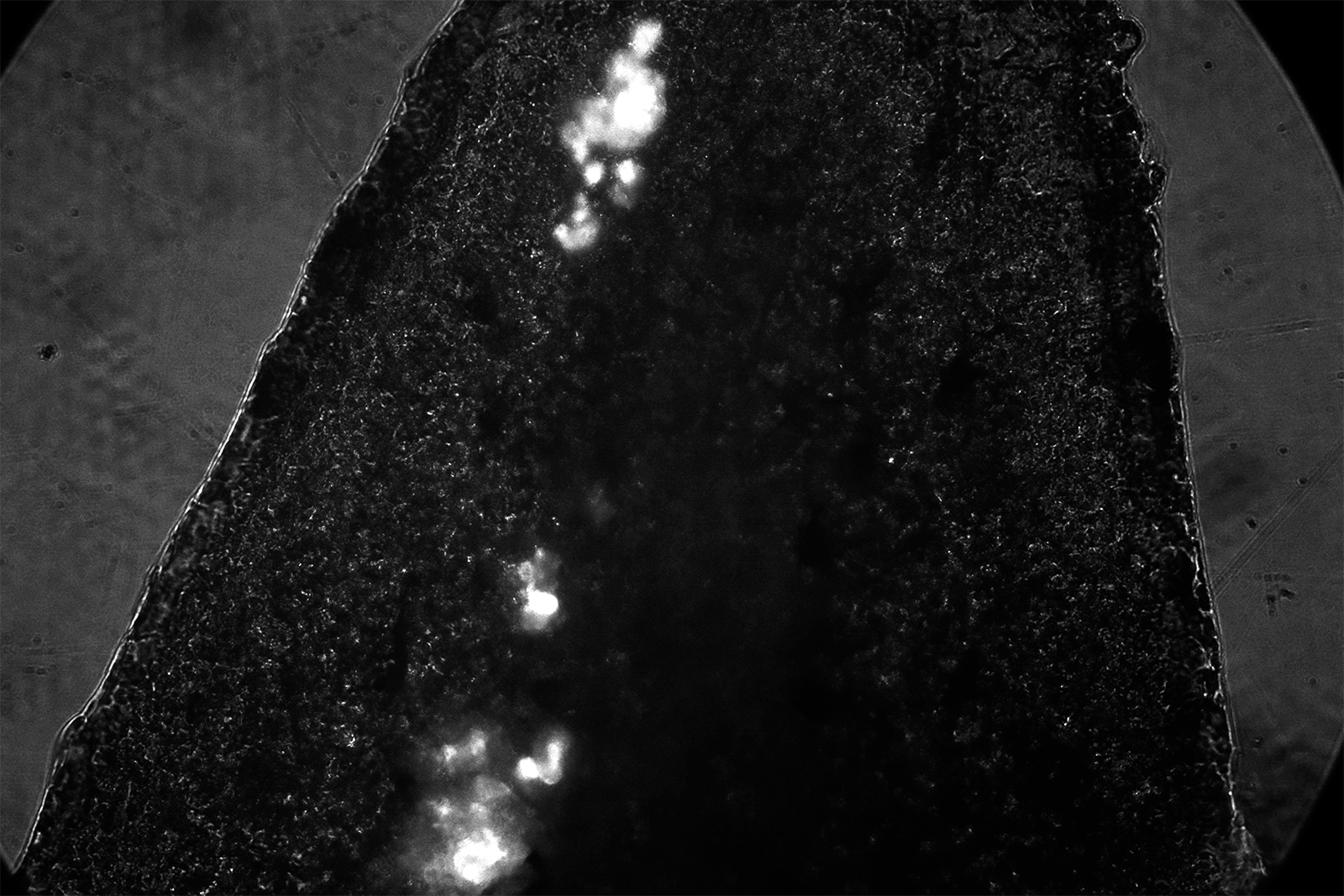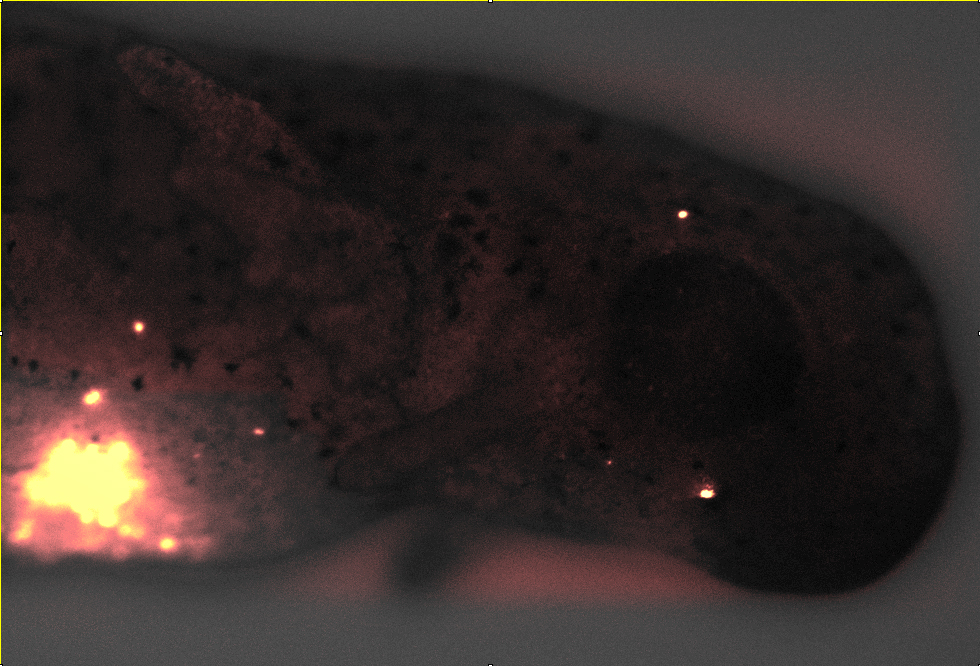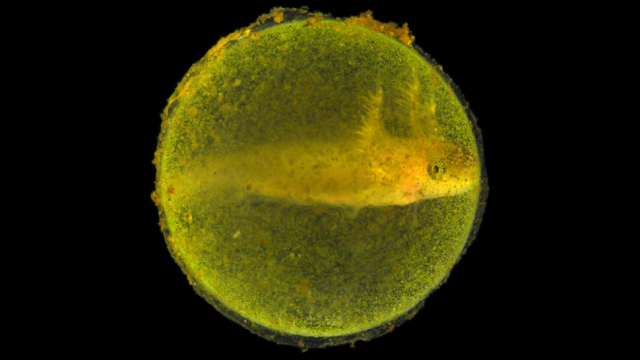In a scientific first, researchers have discovered a bizarre inter-species relationship in which salamanders and algae cosy up together to share cells. Scientists aren’t entirely sure why these two very different organisms have adopted such an intimate arrangement, but the discovery could represent a completely new form of symbiotic relationship.
A single spotted salamander embryo encased in an egg. (Image: Roger Hangarter)
Cell-within-cell arrangements between species are common in nature, but up until this point it’s only been seen in creatures like coral, clams, and insects. New research published in the science journal eLife describes the first known example of photo-cellular symbiosis involving the cells of a fully grown vertebrate animal, that is, an animal with a spinal column or backbone.

An adult spotted salamander. (AMNH/E. Chapman)
As a collaborative research team from the American Museum of Natural History and Gettysburg College revealed, the green alga Oophila amblystomatis makes its home inside of cells located across the body of the spotted salamander Ambystoma maculatum. The salamander doesn’t appear to be negatively affected by its microbial roommates, and in fact the amphibian may even be benefitting from this arrangement. The normally photosynthetic green algae, on the other hand, are completely stressed out, forced rely on an alternative means of energy production.
The finding is so strange and so unexpected that the scientists involved in the study aren’t sure why this relationship evolved in the first place, or how each creature might be benefitting.
Intracellular “mutualists,” as they’re called, are extremely common in nature, where both parties benefit from the relationship. Examples include single-celled dinoflagellates that accumulate on coral and giant clams and use photosynthesis to provide sustenance to their hosts, and gut bacteria that helps bugs break down plant compounds.
Back in the late 19th century, biologists learned that green algae grows in the egg cases of spotted salamanders, providing a win-win situation for both; the embryos produce nitrogen-rich waste for the algae, and in turn, the algae increases the oxygen content found in the fluid around the breathing embryos through photosynthesis. For well over a century, scientists had assumed that this mutually-beneficial arrangement only occurred between the salamander embryo and the algae living outside it.
But the green algae is not limited to the egg cases — it’s also located inside cells of a mature salamander’s body. As previous research has shown, the algae enter the eggs, proliferate, and then later invades the tissues and cells of the developing embryos. Aside from the initial egg and algae symbiotic relationship, it wasn’t known if this subsequent arrangement incurred any kind of benefit, or if it was simply a residual or parasitic infection.

A spotted salamander embryo’s tail with endosymbiotic algae. The algae are visualized by chlorophyll fluorescence, seen here as bright white regions of the image. (Image: AMNH/J. Burns)
To investigate this unusual relationship, John Burns from the AMNH’s Museum’s Division of Invertebrate Zoology sought to uncover what happens when the salamander cells and green algae cells are together. Using a technique called RNA-Seq, the researchers sequenced the RNA (a single-stranded copy of DNA that helps cells make proteins) of both organisms, and then used those sequences to learn how the algae and salamanders changed their patterns of gene expression while interacting.
As the data revealed, salamander cells containing green algae recognised the algae as foreign, but the salamanders showed no signs of distress.
“The salamander really doesn’t seem too bothered by this [arrangement],” Burns told Gizmodo. “In fact, there are tantalising hints that the salamander is actually responding in a way that dampens its immune response to this alga. Some genes related to slowing down a potent immune response were highly expressed by the salamander in this association.”
These changes to the salamander’s immune system suggest the host cell experience is either neutral or beneficial. But the same cannot be said for the green algae, which appears to be struggling in its foreign host.
“For its part, the alga undergoes drastic changes,” said Burns. “Unlike the alga in the coral-alga symbiosis, the alga in this interaction is stressed, and rather than producing oxygen and sugar through photosynthesis, it is fermenting. This suggests that the alga is in a relatively low oxygen environment.”

A spotted salamander embryo with large numbers of algal cells inside its tissues. The algae are visualized by chlorophyll fluorescence, seen here as yellow-orange bright regions of the image. (Image: Ryan Kerney)
Burns said this fermentation response could also be triggered by sulphur deprivation, which is an important mechanism used by the biofuels industry for getting algae to produce hydrogen. And indeed, the intracellular alga do appear relatively starved for sulphur.
So what’s going on here? Why do the algae go to all the trouble of setting up camp in the tissues of salamanders only to get stressed out? The researchers aren’t entirely certain, but they have no shortage of theories.
One possibility is that the relationship protects the salamander from pathogens. The salamanders allow the green algae to enter their tissues and cells, but the salamander’s immune response may actually block more harmful pathogens from doing the same. The arrangement could offer salamanders protection once they hatch into the more hostile environment of the pond. “This would be something like a ‘defensive symbiosis,’ which is only theoretical at this point,” said Burns.
It’s also possible that the green algae — despite having to use fermentation to produce energy — is benefitting the salamander cells by producing nutrients, albeit fewer than they would normally produce under high oxygen conditions. “Also, though photosynthesis seems to be tuned down, it is still active and may be aiding the alga to use some energy from the sun through modified pathways,” said Burns. Which, if true, would be really cool — it means the amphibian is indirectly benefiting from photosynthesis in a manner similar to how coral does.
More speculatively, the arrangement may represent a way for the algae to persist in the salamander over the long haul, and enable the algae to jump from a parent salamander to its offspring in a process known as vertical transmission. In other words, it’s a part of the green algae’s reproductive cycle. “However, at this point, that is just a wild guess,” admitted Burns. “We need more work to explore the long term fate of the intracellular alga.”
Regardless of the reason, this discovery is changing our thinking about photo-symbioses. More examples like this may exist in nature. Looking ahead, the researchers would like to explore how the algae takes root in the salamander.
“We are very interested in doing more research imaging the algal cells as they enter the salamander tissues and cells,” study co-author Ryan Kerney told Gizmodo. “New advances in microscopy could give us additional insights into the dynamics of tissue entry, and even the exchange of molecules between symbiont and host.”
The researchers would also like to study the eventual fate of the intracellular algal cells.
“They could be destroyed/absorbed over the course of salamander development. But they could also persist and be vertically transmitted,” said Burns. “That is an amazing possibility.”
[eLife]
